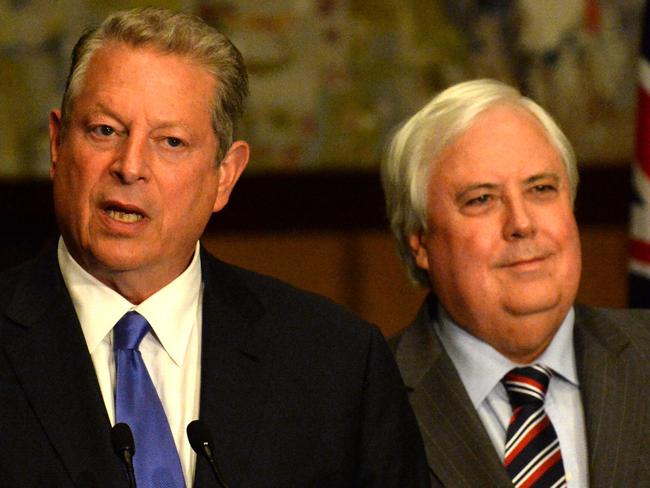Clive Palmer to axe carbon tax, start emissions trading scheme: what’s the difference?
OMG! PUP will axe the carbon tax, keep the RET and CEFC and build a new ETS. WTF can you understand this?

Economy
Don't miss out on the headlines from Economy. Followed categories will be added to My News.
OMG, did you hear the PUP will axe the carbon tax, keep the RET and CEFC and try to build a new ETS one day?
Once more in English please? Younger generations, addicted to their iPhones and tweets, may thrive on this sort of abbreviation.
But murky acronyms and a lack of clarity have mired our national debate about climate change and society’s best response.
So here it is, my quick easy guide to the climate change jargon, so you can play along at home with all the Clive Palmer meets Al Gore political craziness.
CONDITIONS ATTACHED: Clive Palmer backs Abbott on carbon tax
ANALYSIS: Simon Benson: Clive Palmer and Al Gore — what went on

CARBON TAX
Alright, so the starting point of the entire climate change debate is that scientists believe humans are emitting too many greenhouse gases — mostly carbon dioxide — into the atmosphere.
This creates a greenhouse effect, whereby the sun’s heat can’t escape the earth. This makes the planet warmer than otherwise, which causes the sea to expand, sea levels to rise, polar ice caps to melt, weather patterns to change etc.
So far, so easy.
If we want to reverse the situation, we need to emit less pollution into the atmosphere. So our overriding policy objective is to reduce emissions.
The crudest way to do this is to slap a tax on carbon. Companies who emit carbon into the atmosphere have to pay a tax, which is set at a dollar amount per tonne of carbon emitted.
Companies can protect their profits by either reducing their emissions, or passing on the cost of the carbon tax to their customers, through higher electricity price. Probably, they do both.
Under such a scheme, the government guesses the level of tax that will be required to bring about a desired amount of emissions reduction.
But it’s a bit of a stab in the dark. Set the price too low, and companies don’t change their behaviour. Set the price to high, and you unfairly harm business.
CLIVE PALMER: ‘I don’t think Tony Abbott is evil’
TUMULTUOUS PAST: How Clive Palmer works
EMISSIONS TRADING SCHEME (ETS)
The alternative, preferred by economists, is to start out by imposing a strict limit on the total amount of pollution that can be emitted into the atmosphere.
Companies are then required to have permits to cover the amount of pollution they emit. Permits are allocated once a year. If companies want to emit more than their allocation, they have to purchase more permits. Companies do the right thing, and reduce their emissions below their allocated amount, can sell their excess permits. A market is created in which heavy polluters come to buy excess permits and light polluters come to sell their unused ones.
The price of these permits is determined by the forces of supply and demand — no heavy hand of government required.
So what does Australia currently have? A carbon tax or an ETS?
Here’s the twist — we have both. Australia’s carbon tax is, in reality, set up like a fixed price emissions trading scheme. For the past two years, companies have been buying and selling permits — just at a price fixed by the government.
We were supposed to transition to a floating price scheme from July 1, 2015 (Labor promised at the last election that it would have moved that forward to next Tuesday).
Instead, thanks to Clive Palmer’s intervention last week, both the carbon tax and this nascent emissions trading scheme will be ripped up by the end of next month.
Palmer claims he wants an ETS. But in reality, all he will have done is rip up our existing one.
RENEWABLE ENERGY TARGET (RET)
Palmer will, however, save several other important acronyms, starting with the Renewable Energy Target. Under the target, 20 per cent of Australia’s electricity must come from renewable sources by 2020.
Combined with government subsidies for solar and wind, the RET is forcing energy suppliers to develop or invest in more renewable energy sources.
Let’s not mess about. Renewable energy is more expensive upfront than continuing to burn the dirty lumps of coal that Australia has in abundance. It is expensive to build solar panels and wind turbines. But, once built, their marginal cost is close to zero. The wind and the sun are free, after all.
This means cheaper power prices for consumers in the long run when the price of scarce fossil fuel energy sources, like coal but particularly gas, rise as shortages emerge.
The government hadn’t made a decision about whether it wanted to abolish the RET — particularly given its own modelling shows this would mean higher prices for consumers down the track — but Palmer’s action ensures it survives.
CLEAN ENERGY FINANCE CORPORATION (CEFC)
Also to survive the axe is another government scheme aimed at encouraging upstart projects which reduce emissions. The CEFC acts like a private bank and is headed by former Reserve Bank board member Jillian Broadbent. The goal is to invest taxpayer money in projects which otherwise wouldn’t get funding and to encourage the private sector to invest too.
Currently it has invested $700 million of taxpayer funds, encouraging the co-contributions worth $1.3 billion from the private sector, for renewables projects, including solar, wind and bioenergy.
The fund has a mandate to lend up to $10 billion of taxpayer funds. As long as the investment decisions are sound, and so far they seem to have been, taxpayers will get back their initial investment, plus a rate of return. Win win.
DIRECT ACTION
Of course, the Abbott government’s preferred way to reduce emissions (remember it too is committed to reduce emissions by 5 per cent by 2020 from 2000 levels) is Direct Action.
This essentially involves the government picking winners, selecting projects to receive government subsidies. Companies have to then demonstrate they have used the money to reduce their emissions from a certain baseline. Penalties apply if they don’t.
The problem is there’s nothing to stop other companies, who don’t get subsidies, simply continuing to increase their emissions.
Overall pollution levels may continue to rise, meaning taxpayers are footing the bill for subsidies which are not achieving the policy’s aim: emissions reduction.
So there you have it. By the end of next month it’s likely Australia will have no carbon tax, no ETS and no Direct Action plan in place to tackle emissions. All we will have a CEFC and a RET, which will help, but are just not enough to significantly reduce emissions.
Which may well leave some Aussies concerned about climate change thinking: WTF?
*Jessica Irvine is National Economics Editor
Originally published as Clive Palmer to axe carbon tax, start emissions trading scheme: what’s the difference?


